Criminology is a field of sociology that studies individual interactions, interaction, and organization in the past. It does, however, incorporate studies and notions from other disciplines including as philosophy, anthropology, biology, and psychology.
The purpose of a Bachelor of Criminology degree for many criminologists, is to figure out what causes criminal behavior and how to avoid it in a humane and effective way. These objectives have given rise to a number of schools of thought within the subject, each of which examines different aspects of aberrant behavior and draws different findings about how to effectively address the difficulties.
The subject of Criminology is not one to be toyed about, hence needs to be studied in-depth. Speaking of studying Criminology to the core, you might wonder if they’re are universities in Canada in which one can be thought the field of Criminology to the core with proofs and uninterruption. Look no further!
Today’s article would be listing best criminology universities in Canada and in extension, the best criminology universities in the world along with the criminology degree requirements you should check before you can study criminology in Canada. Without wasting more time, let’s dive in!
1. University of Guelph
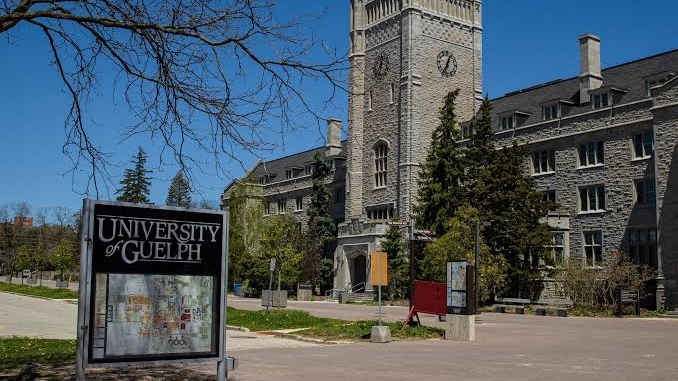
It has been recognized by the Globe and Mail as medium sized best criminology universities in the world known to offer student satisfaction. Its renown, innovative research-intensive programs, and vibrant campus culture have all been noted as specific strengths among what make it rank among the best criminology universities in the world.
The university’s Hospitality and Tourism Management program has the highest research index in Canada, according to the Journal of Hospitality & Tourism Research. In Times Higher Education’s list of the top 100 universities under 50 years old, the University of Guelph was ranked 50th.
Criminology studies is priority at the university, which has produced degree holders of masters in criminology in Canada.
Guelph University was placed 16th among Canada’s top 50 research universities in 2018.
The university was ranked seventh nationwide in the social sciences and humanities by Higher Education Strategy Associates in 2012. Quacquarelli Symonds (QS), the compilers of the annual World University Rankings, have given the University of Guelph a five-star grade.
That’s not all, according to the QS World University Ranking, the Ontario Veterinary College at the University of Guelph was placed No. 1 in Canada and No. 5 in the world in 2020.

University of Guelph was ranked in the top three in 15 of 19 categories among medium-sized best criminology universities in the world The Globe and Mail’s Canadian University Report. This included winning first place in course registration, academic counseling, student dormitories, information technology, campus atmosphere, environmental commitment, and work-life balance.
University of Guelph Campuses
The main university campus covers 412 hectares of land with the main Arboretum having a distance length of 165 hectares and a park solely meant for research covering up to 12 hectares.
The campus also features a number of prominent midcentury modernist structures, particularly in the Brutalist style, that were built during the school’s expansion plan in the 1960s.
The campus is densely forested, with trees lining several of the main paths, which are lined with red clay brick. An arboretum is located on site.
University of Guelph Security Status
The University of Guelph Campus Community Police, First Response Team, and Fire Safety officers provide security on campus.
University of Guelph Campuses — Ontario Agricultural College (OAC)
The Ministry of Agriculture, Food, and Rural Affairs ran the Ontario Agricultural College, which maintained a network of campuses and research stations across the province.
The OAC operates on over 180 acres in Guelph and at the former Ridgetown College of Agricultural Technology in Ridgetown, Ontario (450 acres).
This site does not have any degree programs. Instead, with two and three year diploma programs, the concentration is on technology transfer. Agriculture, veterinary technology, environmental management, and horticulture are among the specialties.
Performance horse handling and veterinary office administration are also available as one-year certificate programs at this site.
Dairy Herdspersons can also participate in an apprenticeship program (new for 2017).
University of Guelph Campuses—Guelph- Humber Campus
The University of Guelph-Humber was founded in 2002 as a satellite campus of the University of Guelph and Humber College.
It is located on the North Campus of Humber College in Toronto and offers seven four-year academic programs that lead to an honours degree from the University of Guelph and a Humber College diploma.
The Guelph-Humber campus has 4,174 full-time and 503 part-time undergraduate degree students enrolled in the fall of 2015.
University of Guelph Criminology Degree Requirements
Below is enlisted documents that need to be handy if you intend to pursue a diploma in criminology in Canada.
1. Students must have a minimum “B” average on a four-year undergraduate degree (or equivalent). Only students with a “B+” or higher average are expected to be considered for admission.
Application Fee:
The application fee for international students can be between $90 and $110.
You can apply here.
English Proficiency
Below are the recommended least scores to have in order to study Criminology at University of Guelph
CAEL (Canadian Academic English Language Test) – 70 points
IELTS test – 6.5
MELAB – 85 points
TOEFL Internet-based test (iBT) (Test of English as a Foreign Language) Note: Each of the four areas (listening, speaking, reading, and writing) must have a minimum score of 21 – 89.
Scholarships
University of Guelph Undergraduate Commonwealth Scholarship.
Note: If you’re an African American student, you can get more information regarding scholarships here.
2. Simon Fraser University
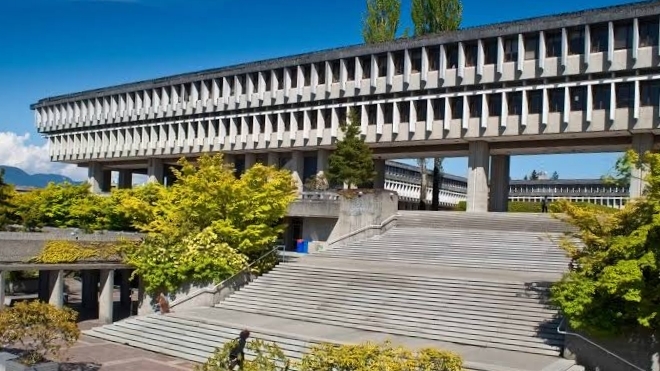
Simon Fraser is the first Canadian member of the National Collegiate Athletic Association, the world’s largest college sports association, and has consistently been ranked as Canada’s top comprehensive university.
It was also named to the Times Higher Education list of 100 best criminology universities in the world under 50. In 2015, SFU became the Northwest Commission on Colleges and Universities’ second Canadian university to be accredited. Fraser University was the school’s original name, but it was scrapped because it suggested a vulgar thought.
Gordon M. Shrum was named the university’s first chancellor in May of that year. Shrum advocated to the provincial government that the peak of Burnaby Mountain, at 365 meters above sea level, be chosen as the site for the new institution. The institution was designed by architects Arthur Erickson and Geoffrey Massey, and building began in the spring of 1964. The campus looks out over Burrard Inlet to the northwest.
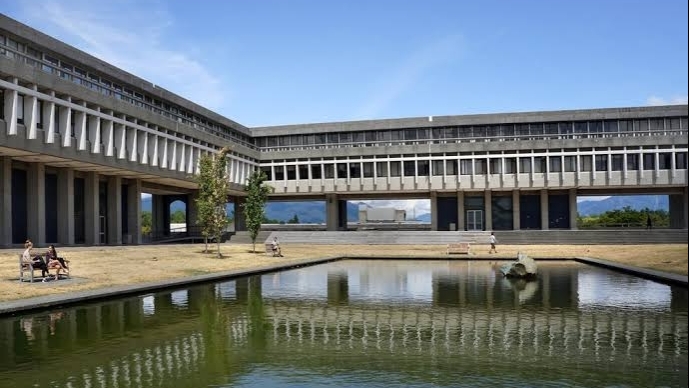
On September 9, 1965, the institution began its inaugural semester with 2,500 students, eighteen months later. In competitions for federal research council funding from the Natural Sciences and Engineering Research Council (NSERC) and the Social Sciences and Humanities Research Council (SSHRC), SFU has the highest publication impact and the highest success rates per faculty member among Canadian comprehensive universities (SSHRC) showing this by producing masters in criminology in Canada and the world in extension.
In 2007, the university began working with other best criminology universities in the world to offer dual and double degree programs, such as producing masters in criminology in Canada and a double Bachelor of Arts degree with Monash University in Australia.
SFU celebrated its 50th anniversary on September 9, 2015. Over 130,000 people have graduated from the university throughout its 50 years of existence.
Simon Fraser University Campuses — Burnaby Campus
The main campus is located at a height of 365 meters, with a view of the Burrard Inlet to the north.
The Burnaby campus houses all of the university’s major departments. The W. A. C. Bennett Library on the main campus is named after the Social Credit Premier of British Columbia who established it.
The Lorne-Davies Complex and Chancellor’s Gym are two gym facilities on campus. Within the Lorne-Davies Complex is an international-sized swimming pool.
Burnaby campus production theatre has been unoccupied since the School of Contemporary Arts relocated to the Woodward’s facility.
The Museum of Archaeology and Ethnology, as well as three art galleries, are located in the core of the campus. The campus has won various architectural accolades throughout the years, including the gold medal for Lieutenant-Governor 2009 Awards in Architecture and the ‘Prix du XXe siècle’ from the Royal Architectural Institute of Canada in 2007. From the eastern end of the campus to the western side, where the UniverCity urban village is located, the Burnaby campus is made up of a huge complex of interconnected buildings spanning 170 hectares (420 acres) of land on Burnaby Mountain.
Simon Fraser University Campuses — Surrey Campus
The Surrey campus is made up of two buildings in the Whalley/City Centre area of Surrey. The main structure is part of Central City, a mixed-use development near the Surrey Central SkyTrain station.
Since then, it has grown to accommodate the Surrey operations of other SFU programs. Bing Thom designed the Central City complex that houses the college, which opened in 2006.
The Fraser Library, a branch of the SFU Library, is located on the second floor of this campus and is the only branch having an arcade and console games room.
It also lends equipment to the School of Interactive Arts and Technology’s students.
Simon Fraser University Campuses — Vancouver Campus
The Vancouver facility began as a storefront classroom in the 1980s. It was British Columbia’s first urban university classroom.
The private sector provided a large share of the funding for the campus’ construction. SFU Harbour Centre, Morris J. Wosk Centre for Dialogue, Segal Graduate School of Business, SFU Contemporary Arts at the restored Woodward’s Building, SFU Charles Chang Innovation Centre, SFU Vancity Office of Community Engagement at 312 Main, SFU VentureLabs, SFU Collection at Bill Reid Gallery of Northwest Coast Art, and SFU Contemporary Arts at 611 Alexander Visual Arts Studio are the eight buildings that make up the Vancouver campus.
On May 5, 1989, the original campus building at Harbour Centre, a refurbished heritage department store, opened its doors. The entire campus now serves over 70,000 individuals each year.
Around 10,000 graduate and undergraduate students are enrolled in downtown courses and degree programs. The Vancouver campus is home to the Belzberg Library.
Simon Fraser University Criminology Degree Requirements
You need to have these documents handy when apply for Simon Fraser University:
1. Resume: A summary of academic achievements and/or awards, publications, relevant employment experience, and/or volunteer activities.
2. Students must fill out an online application form on the official website.
3. All transcripts from post-secondary institutions: Students must present all official documents detailing their grades. Undergraduate, graduate, medical school, law school, and other higher education transcripts are all referred to as post-secondary transcripts.
Note only for West African students:
Results of the West African Senior Secondary School Certificate (WASSCE) using WAEC scratch data. Secondary schools will send transcripts to students.
Transcripts for post-secondary students must be submitted to their universities.
4. Three professional or academic references: Academics should be commented on by referees (teachers, guidance counselors, or professors), and references should be submitted with the application system.
5. Official electronic transcripts: Official transcripts from all post-secondary institutions attended should be sent in PDF format.
6. Personal Statement: It should include a brief outline of the student’s background, strengths, and any relevant job experience and/or education.
7. Statement of research interests: Students must fill out the application form with their favorite research topic.
8. ELP Scores: Students must provide their IELTS, TOEFL, or equivalent exam scores to demonstrate their English language competency.
TOEFL: 88 / 120
IELTS: 6.5 / 9
PTE: 65 / 90
Application Fee:
The application fee for international students can be between $90 and $125.
You can apply here.
Scholarships
Undergraduate Scholars Entrance Scholarship (USES).
3. Coast Mountain College
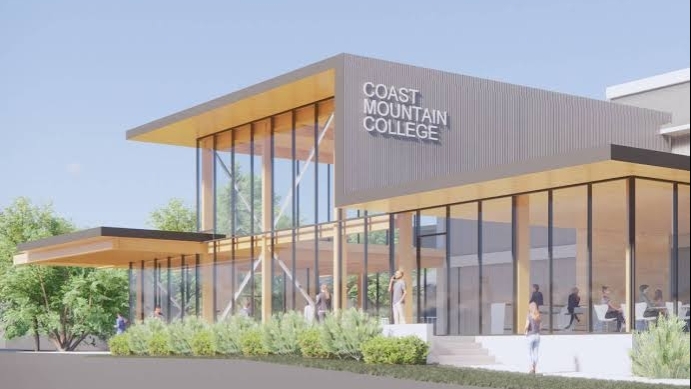
The school first started in September 1968, with 295 pupils enrolled in 1968-69.
On August 11, 1970, the building was officially opened. In 1975, Northwest College was founded on the site. The name was soon changed to Northwest Community College (NWCC), then on June 18, 2018, it was renamed Coast Mountain College.
Totem poles and traditional art that depict the history of the surrounding areas and peoples are on exhibit on college campuses, and have been commissioned for organizations outside the region, including those in the United States and China.

In 2003, the college joined the Provincial Learning Network (PLNET), which was later upgraded to BCNET’s Advanced Network in 2019, bringing all BC universities and colleges online.
Coast Mountain College Campuses — Terrace Campus
The main facility is around 5 kilometers from downtown Terrace and sits on 30 acres. The college has bilingual Sm’algyax and English names and signage.
Waap Sa’mn (House of Spruce), Waap Amgam (House of Cedar), Waap Haawk (House of Birch), Waap Sginiis (House of Jackpine), and the 230,000 square foot student housing building Wii Gyemsiga Siwilaawksat are among the structures (Where learners are content and comfortable.).
In September 2018, CMTN revealed a $18.4 million state-of-the-art refurbishment to their Waap Amgam (House of Cedar) trades building. Waap Galts’ap, the 6,000 square foot campus Longhouse, is located on the south end of campus. The Longhous, which was built in 2006, is primarily utilized for student-centered and cultural activities making it among the best criminology universities in the world and it hosting varieties of events throughout the year.
The Northwest Trades & Employment Training Centre is a satellite campus in the Thornhill neighbourhood of Terrace (NTETC).
The two-building complex of roughly 50,000 square feet in downtown Prince Rupert was built in 2004 on a $12 million budget.
The world-renowned Applied Coastal Ecology program is located on campus. The University of Northern British Columbia has a campus on the CMTN Prince Rupert campus.
A huge library, various seminar rooms, trades facilities, a Learning Resource Centre, student lounge, 19 classrooms, two computer laboratories, two science labs, and the innovation lab are all located on the Prince Rupert site.
Coast Mountain College Campuses — Smithers Campus
The present Smithers campus is located on Second Avenue and was built for $17 million in 2011.
The 20,000-square-foot Gold LEED facility was designed with wood, rock, and Indigenous art to represent forestry, resource management, and Indigenous culture. The Smithers campus is home to the Bulkley Valley Learning Centre.
Coast Mountain College Campuses— Haida Gwaii Campus
The Haida Gwaii campus of Coast Mountain College is located in the settlement of Masset.
In 2013, the Masset campus relocated to a designated location at Tahayghen School.
Coast Mountain College Criminology Degree Requirements
The documents needed for this university is no different from other typical Canadian schools.
Here are the major English proficiency requirements:
1. TOEFL (internet-based): 20 for reading, 20 for writing, 20 for speaking, 20 for listening, and 80 for overall.
2. Overall 6.0 in IELTS (academic module). A minimum of 5.5.
3. ILAC (International Language Academy of Canada): At least a pass mark.
4. Grade “C” on the International Test of English Proficiency (iTEP).
5. CAEL (Canadian Academic English Language Assessment): 50 in total A minimum of 50.
6. Pearson’s Exam (PTE-A): 50 points overall There are 42 of them.
Scholarships
Alma VanDusen Bursary.
BC Hydro Award
BC Oil and Gas Commission Indigenous Education Award.
Application Fee:
The application fee for international students is $100 only.
You can apply here.
4. University Of Manitoba

The university has a reputation for being a top research-intensive post-secondary educational institution, conducting more research annually than any other university in the region, and its competitive academic and research programs have produced some masters in criminology in Canada.
Nobel Laureates, Academy Award winners, Order of Merit recipients, and Olympic medalists are among the University of Michigan’s alumni.
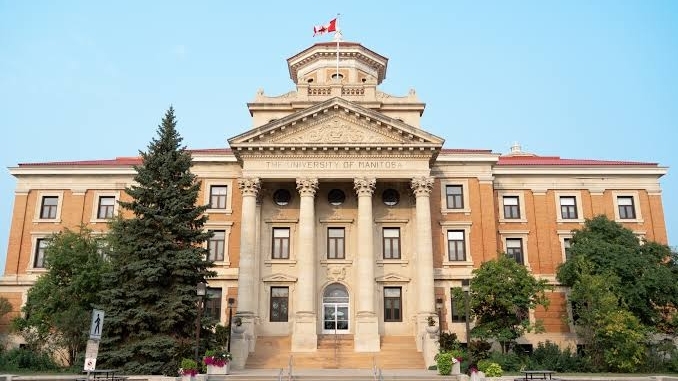
Furthermore, numerous government officials have graduated from the university, including provincial premiers, Supreme Court justices, and Members of Parliament (MPs).
As a result of its increased global outreach, the university now has one of Canada’s most internationally diverse student bodies.
University of Manitoba Campuses — The William Norrie Centre
The William Norrie Centre, located at 485 Selkirk Avenue, is home to the Faculty of Social Work’s “Inner City Social Work Program.”
The program is for low-income mature students (21 years or older) in Winnipeg who have volunteer experience in the city and require academic assistance.
As an extension of the Faculty of Social Work on the Fort Garry campus, the Northern Social Work Program offers a Bachelor’s degree in Thompson, Manitoba.
University of Manitoba Campuses — James W. Burns Education Centre
The Asper School of Business Executive Education program, which includes training in professional development, executive leadership, and other areas, is housed in the James W. Burns Executive Education Centre.
The building, which is located on the second floor of 177 Lombard Avenue, near Portage and Main in downtown Winnipeg, was built in 1911 as the new headquarters for the Great-West Life Assurance Company. It was listed as a provincial historic site in 1985.
University of Manitoba Campuses — Bannatyne Campus
The Bannatyne Campus of the University of Manitoba is a ten-building complex in central Winnipeg that houses the university’s health sciences section.
This facility is located 13 kilometers north of the Fort Garry site, between McDermot and William Avenues, to the west of Winnipeg’s Health Sciences Centre (HSC).
The Rady Faculty of Health Sciences was founded in order to bring the university’s health education community together.
The Rady Faculty includes the Max Rady College of Medicine, the Dr. Gerald Niznick College of Dentistry, the College of Rehabilitation Sciences, the College of Pharmacy, and the College of Rehabilitation Sciences, as well as the College of Nursing, which is still located on the Fort Garry site.
The Manitoba Medical Alumni Association also erected the Medical Corps Memorial on this campus, dedicated to the memory of the University of Manitoba Medical College graduates and students who died in the North West Rebellion (1 name); the 1900 South African War (1 name); and The Great War [i.e., World War I] (7 names).
University of Manitoba Criminology Degree Requirements
You must meet the following requirements:
1. Demonstrate command of the English language.
2. Meet the general entrance criterion for your country or academic program. Thatis, having excellent scores in the TOEFL and IELTS test.
3. Meet program-specific prerequisites for your chosen program(s).
Application Fee:
The application fee for international students is $200.
You can apply here.
Scholarships
University of Manitoba Scholarships
5. University of Alberta

The institution is a “comprehensive academic and research university” (CARU), which means it offers a wide range of academic and professional programs leading to undergraduate and graduate degrees.
Its yearly economic impact on Alberta is projected to be $12.3 billion, or 5% of the province’s gross domestic product. The university was modeled like a state university in the United States, with a focus on outreach and practical research which has attracted potential masters in criminology in Canada.
The bicameral structure was inspired by Ontario’s University of Toronto Act of 1906, with a senate (faculty) in charge of academic policy and a board of governors (citizens) in charge of finance policy and official power in all other affairs.
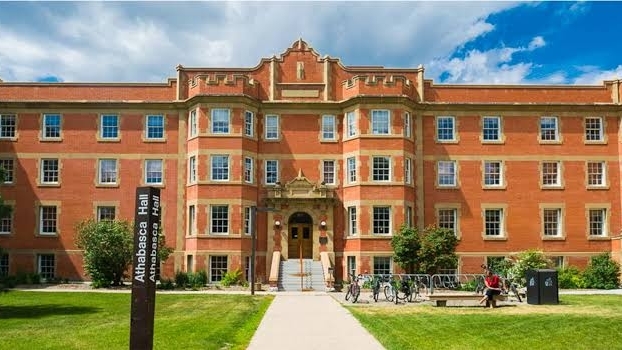

The president, who was chosen by the board, was to serve as a liaison between the two bodies and to govern the institution.
About 39,300 students attend the University of Alberta, including 7,700 graduate students and 7,800 international students from 151 countries. The university employs 3,620 academics and 15,380 support and trust personnel.
Since 1986, university instructors have received 41 3M Teaching Fellowships (Canada’s top award for undergraduate teaching quality), more than any other Canadian university.
There are around 388 undergraduate and 500 graduate programs available at the university. In September 2003, the University of Alberta shifted from a 9-point grading scheme to a more typical 4-point grading scale. The University of Alberta has sent 72 Rhodes Scholars to the United Kingdom.
The University of Alberta also has the most Academic All-Canadians (2,599) of any Canadian university.
The university belongs to the U15 universities and the Worldwide Universities Network, which is made up of 19 universities from six continents.
The University of Alberta was named the fifth top research university in 2018 by Research Infosource, with $513.313 million in sponsored research income (external sources of financing) in 2017. In the same year, the university’s faculty earned an average of $242,100 in sponsored research, while graduate students earned an average of $69,400. External funding for research amounts to over $500 million each year at the university. Over 400 different research laboratories are housed at the university.
Several bibliometric university rankings have recognized the university’s research accomplishments, which employ citation analysis to assess a university’s impact on academic publications.
The university was ranked 81st in the best criminology universities in the world ranking and fourth in Canada in the Performance Ranking of Scientific Papers for World Universities in 2019, and 78th in the world and fourth in Canada in the University Ranking by Academic Performance 2018–19 rankings.
University of Alberta Admission Requirements
Here are essential academic documents you need when pursuing a diploma in criminology in Canada:
1. Resume: A summary of academic achievements and/or awards, publications, relevant employment experience, and/or volunteer activities.
2. Transcripts: Submit a school transcript that lists all of the high school courses pupils have taken and grades they have obtained, as well as any classes they are currently enrolled in.
Note for West African students: Results of the West African Senior Secondary School Certificate (WASSCE) using WAEC scratch data. Secondary schools will send transcripts to students. Transcripts for post-secondary students must be submitted to their universities.
3. Three reference forms and letters of recommendation must be completed and supplied immediately to the web site by referees (teachers, guidance counselors, or professors).
4. Research Proposal: A two- to five-page explanation of the planned research study, including an overview of the pertinent legal issues, preliminary arguments, and research methodology.
5. Statement of Intent: Justifications for enrolling in this program, as well as a description of previous experience.
6. It is a statement of motivation that ties areas of interest and professional objectives, as well as previous education and job experience, to the programs and work done at the University of Alberta.
7. ELP Scores: Students must provide their IELTS, TOEFL, or equivalent exam scores to demonstrate their English language competency.
TOEFL: 90 / 120
IELTS: 6.5 / 9
PTE: 61 / 90
Duolingo: 115 / 160
Application Fee:
The application fee for international fee is $125.
You can apply here
Scholarships
Alexander Rutherford Scholarship
Continuing Scholarships
Discover University of Alberta Award
Loran Award
Schulich Leader Scholarship
Transfer Scholarships
Turtle Spirit Pathway Scholarship
6. St. Thomas University
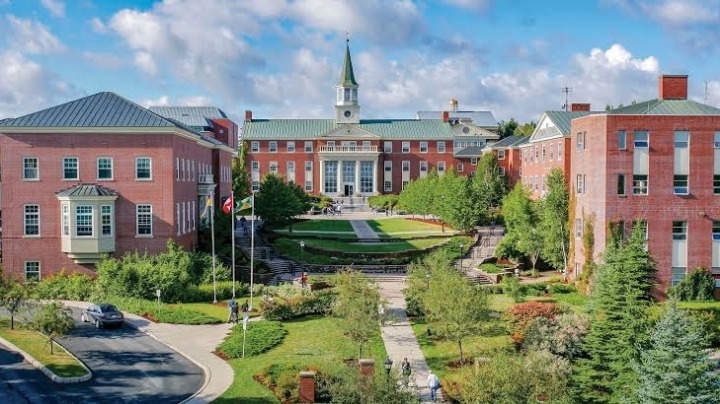

A number of distinctive programs are available at the university, including recognized majors in criminology, journalism, human rights, and communications and public policy.
The Frank McKenna Centre for Communications and Public Policy is located in St. Thomas. Because of its single focus on liberal arts and commitment to social justice, the university is unique in Canada.
A Canadian prime minister, Brian Mulroney, a New Brunswick premier, Shawn Graham, federal and provincial cabinet ministers, prelates, university presidents, and many Rhodes Scholars are among St. Thomas’ prominent graduates. On campus, there are six academic buildings including classrooms and faculty offices. James Dunn Hall, Edmund Casey Hall, George Martin Hall, Brian Mulroney Hall, Holy Cross House, and Margaret Norrie McCain Hall are the names of the buildings.
The J.B. O’Keefe Centre is STU’s athletic facility.


At St. Thomas University, there are four residence buildings. Three are on campus (Harrington and Vanier Halls, as well as Holy Cross House), and one is a short walk away (Rigby Hall).
Campus police officers are students employed by the university on a yearly basis to manage security during campus activities.
St. Thomas University Criminology Degree Requirements
Below are enlisted important documents you’ll need in order to pursue a diploma in criminology in Canada:
1. Online Application Form
2. School Transcript: Results of the West African Senior Secondary School Certificate (WASSCE) using WAEC scratch data.
Secondary schools will send transcripts to students. Transcripts for post-secondary students must be submitted to their universities.
3. Application Fee
4. English Proficiency Skills: For immediate entry into academic programs, students must meet the minimal English language competency requirements.
TOEFL — 88
IELTS — 6.5
PTE — 58
5. Student Visa
Note: International students with a primary language other than English must take one of St Thomas’ recognized English proficiency examinations to demonstrate English language ability.
The minimum required results for any of the examinations in order to be considered for admission are those that allow admitted students to enroll in the English as a Second Language (ESL) program at the institution.
Application Fee:
The application fee is $40.
You can apply here.
How To Apply
Use the STU Common App to log in. Add Saint Thomas to your school list by clicking this link.
Make sure the school’s name and location are correct, as there are other institutions in other countries with the same name.
To begin your application, follow the steps outlined.
As directed, upload all relevant documentation.
Scholarships
Catholic High School Graduate Scholar.
Presidential Scholarship.
Dean’s Scholarship.
STU Award.
7. Thompson Rivers University
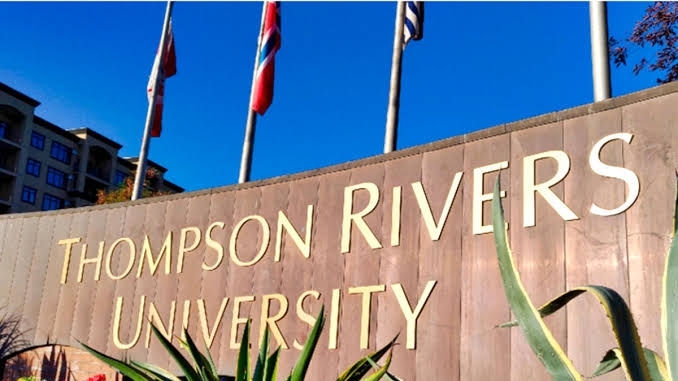

Thompson Rivers University (TRU) is a public research and teaching university that offers undergraduate and graduate degrees as well as vocational training.
Its main campus is in Kamloops, British Columbia, Canada, and its name is derived from the North and South Thompson rivers, which meet at Kamloops.
TRU-Open Learning, a distance education branch, operates a satellite campus in Williams Lake, British Columbia. TRU World, the company’s worldwide business, has various international collaborations.
The Northwest Commission on Colleges and Universities (NWCCU) has granted TRU accreditation at the associate, baccalaureate, and master’s degree levels.

TRU’s Open Learning section provides 140 on-campus programs and about 60 online or distance programs, including trades apprenticeships, vocational certificates and diplomas, bachelor’s and master’s degrees, and law.
The BC provincial government chose Kamloops, the largest population center in the Thompson-Okanagan and Cariboo-Chilcotin regions, as the site for one of several new two-year regional colleges to provide academic and vocational programs outside the urban centers served by the province’s three universities has produced graduates in Canada especially masters in criminology in Canada.
The Brown Family House of Learning, TRU’s first LEED Gold-certified structure, debuted in 2011 as the home of the TRU Faculty of Law, Canada’s first new law school in over 30 years.
In December 2013, TRU Law moved into a 44,000-square-foot location in the freshly restored Old Main building. In June of 2014, Law’s first graduating class convened. TRU had a total headcount of 25,748 students in the 2014-15 academic year, with 11,957 on campus. China, India, and Saudi Arabia topped the list of over 70 countries of origin, accounting for 15 percent of TRU’s on-campus student population (10 percent overall).
Aboriginal students accounted for 10.5 percent of the total student population. Students enrolled in Open Learning, both domestic and international, were 11,903 in total.
Thompson Rivers University Campuses — Kamloops Campus
TRU’s 250-acre main campus in Kamloops is located on McGill Road in the city’s southwest Sahali neighborhood, overlooking the Thompson River’s North and South Forks, from which the university gets its name. The property features 40 acres of gardens and the province’s largest arboretum.
For 880 students, residences provide on-campus lodging. Kamloops, a tiny city with a population of 90,280, is situated in the semi-arid grasslands of British Columbia’s southwestern interior, on the traditional territories of the Secwepemc (Shuswap).
TRU has regional centers at 100 Mile House, Clearwater, Barriere, Ashcroft, and Lillooet, as well as a satellite campus in Williams Lake, BC’s Cariboo-Chilcotin region. The Open Learning branch serves students all over the world.
Thompson Rivers University Campuses — McGill Road Campus
Cariboo College moved to its current campus on McGill Road in September 1971, after a year of operating out of various school district facilities, including the Kamloops Indian Residential School building.
The Kamloops Vocational School shared the newly constructed Main Building. Much of the campus was once a Canadian Navy munitions facility, and several of the officers’ quarters built during that time have been restored and are now used as heritage buildings on campus.
To satisfy the demands of a rapidly growing student body, Cariboo’s campus was always under construction.
The Gymnasium and the Library both opened in the fall of 1976. In 1980, the Science building was finished, and the Visual Arts building opened the following year, replacing the Kamloops Indian Residential School.
Hillside Stadium opened in 1988, and student dormitories began construction in 1989. The Clock Tower building and a Theatre meant for those with Bachelor of Criminology who have graduated were completed in 1989, as was the addition of a second level to the Main building’s B Block for classroom and bookstore space.
Thompson Rivers University Criminology Degree Requirements
Below are enlisted important documents you’ll need in order to pursue a diploma in criminology in Canada:
1. Online Application Form.
2. School Transcript: Results of the West African Senior Secondary School Certificate (WASSCE) using WAEC scratch data. Secondary schools will send transcripts to students. Transcripts for post-secondary students must be submitted by their universities.
3. Application Fee.
4. English Proficiency Skills: For immediate entry into academic programs, students must meet the minimal English language competency requirements.
TOEFL — 88
IELTS — 6.5
PTE — 58
5. Student Visa
Application Fee:
The application fee for international students is between $90 to $125.
You can apply here.
Scholarships
Thompson Rivers University Scholarship
8. University of Ottawa

The University of Ottawa was founded in 1848 as the College of Bytown by Joseph-Bruno Guigues, the first bishop of the Catholic Archdiocese of Ottawa.
It was renamed the College of Ottawa in 1861 and achieved university status five years later under a royal charter under the guidance of the Oblates of Mary Immaculate. Pope Leo XIII handed the university a pontifical charter on February 5, 1889, raising it to a pontifical university.
On July 1, 1965, the university was reorganized as a company, separate from any outside body or religious institution. As a result, the newly formed Saint Paul University, which was federated with the university, preserved the civil and pontifical charters.
The restructured university kept the surviving civil faculty.
The University of Ottawa is the world’s largest bilingual English-French university.
The University of Ottawa Library has 12 locations and houses a collection of about 4.5 million books. With a research income of CA$324.581 million in 2017, the institution is a member of the Canadian U15 group of research-intensive universities.

The school has about 35,000 undergraduate and 6,000 post-graduate students and is co-educational. Around 7,000 international students from 150 countries attend the school, accounting for 17% of the student body.
There are almost 1,950 Bachelor of Criminology degree holders connected to the university. The Gee-Gees are the university’s athletic teams, which compete in U Sports.
University of Ottawa Campuses— Sandy Hill Campus
The university’s main campus is located in the Sandy Hill (Côte-de-Sable) neighborhood.
The ByWard Market sector borders the main campus to the north, Sandy Hill’s residential section to the east, and Nicholas Street to the southwest, which runs parallel Canal on the western part of the campus site. The main campus occupied 35.3 ha (87 acres) as of the 2010–2011 academic year, but the university owns and operates other properties throughout the city, bringing the overall campus area to 42.5 ha (105 acres).
Before settling in its ultimate position in 1856, the main campus shifted twice. The site was originally next to the Notre-Dame Cathedral Basilica when the university was created. In 1852, the campus was relocated across the street from the National Gallery of Canada due to a lack of space. The institution relocated to its current location in 1856.
The university’s buildings range in age from 100 Laurier (1893) to 120 University The average age of buildings in 2011 was 63.
The university owned and operated 30 main buildings, 806 research laboratories, 301 teaching laboratories, and 257 classrooms and seminar rooms during the 2011–2012 academic year.
The main site is separated into two sections: the ancient Sandy Hill campus and the newer Lees campus, which was purchased in 2007. While Lees Campus is not directly contiguous to Sandy Hill, it is included on school maps as part of the main campus.
The Lees campus, which is within walking distance of Sandy Hill, was once an Algonquin College satellite campus.
University of Ottawa Admission Requirements
Your English proficiency scores should be at least or more than the scores recorded below in order to stand a change to pursue a diploma in criminology in Canada.
TOEFL: 86/120
PTE: 60/90
IELTS: 6.5/9
If applicants have passed the CBSE or CISCE senior English subject with a final grade of 75 percent, the ELP requirement may be removed (Indian grading scale) Interim grades (for example, pre-board exam scores) will be utilized if the applicants are currently in secondary school.
Application Fee:
The application fee for international students is $110.
You can apply here.
Scholarships
University of Ottawa Scholarships
9. Laurentian University

The university’s campus is in the Bell Grove neighborhood, just south of Greater Sudbury’s urban centre, on the south side of Ramsey Lake.
The university campus is bordered on the west by the city’s Idylwylde golf club, and on the south by the Lake Laurentian Conservation Area.
A network of paths for running, mountain biking, and nordic skiing may be found in the Lake Laurentian Conservation Area.

There are two student unions at the school (in addition to the graduate student association). The Francophone Students Association (AEF) represents francophone students, whereas the Students General Association (SGA) represents both anglophone and francophone students.
Arts, social sciences, technology, natural sciences, engineering, mining, geophysics, health, business management, finance, and forensics are among the university’s specializations.
Laurentian University filed for bankruptcy protection on February 1, 2021, while claiming to have operated balanced budgets for eight of the preceding nine years. Laurentian University announced the termination of 58 undergraduate programs and 11 graduate programs across a variety of areas as part of its restructuring on April 12, 2021. Around 200 teaching and staff posts were eliminated as a result of the closures. 107 undergraduate and 33 graduate programs are still available at the university.
Laurentian University Campuses — Fraser Auditorium
The Fraser Auditorium, which seats up to 669 people and is located in the Fraser Building, is a large-volume auditorium that is frequently used for the larger first-year classes.
The Fraser Auditorium is divided into three smaller sections when used as a classroom. The Fraser Auditorium is also used for special events and conferences, as well as convocation ceremonies, which take place there every spring.
The Falconbridge Lecture Series has been held at the Fraser Auditorium, with speakers including Chief Justice Beverley McLachlin and Senator Roméo Dallaire (March 2006). The auditorium also hosts cultural events such as theatre and concert performances, and was once home to the city’s Théâtre du Nouveau-Ontario, Sudbury Theatre Centre, and Sudbury Symphony Orchestra.
Laurentian University Campuses — Ben Avery Campus
It features a weight and cardiovascular room, an IAAF eight-lane 400-meter (1,300-foot) Mondo track (2010), a four-lane indoor track, a rock climbing wall, a bouldering room, an Olympic-size swimming pool with high-rise diving boards, squash courts, basketball courts, badminton nets, and the home of the pot-banging cheer squad.
The Ben Avery’s Varsity Gym is where many students take their final exams.
Laurentian University Admission Requirements
Laurentian University’s entrance requirements for international students are listed below.
1. Depending on your place of origin, the Secondary School Certificate/GCE/Secondary School Leaving Certificate/Higher Secondary Certificate/Secondary Education Certificate/WASSCE or any Grade 12 equivalent is required. You must also submit an official transcript to support your secondary school diploma.
2. Laurentian University has language (English/French) requirements for overseas candidates.
English Proficiency Requirements
1. Academic: Minimum overall score of 6.5; no band below 6.0 in the International English Language Testing System (IELTS).
2. TOEFL (Test of English as a Foreign Language): Minimum Internet-Based Test overall score of 88; TOEFL Computer-Based Test total score of 230.
3. Minimum total score of 70 on the Canadian Academic English Language (CAEL) test; no band lower than 60.
4. Pearson Minimum total score of 60 on the Pearson Test of English (PTE Academic).
5. CanTEST (Canadian Test of English for Scholars and Trainees): Overall score of 4.5; no band below 4.
6. Minimum score of 176 on the Cambridge Assessment English test (C1 Advanced/C2 Proficiency).
7. Due to COVID-19, the DuoLingo English Test is only permitted for a short period.
Application Fee:
The application fee for international students is $100.
You can apply here.
Scholarships
Laurentian University Students Scholarships
10. College Of New Caledonia

The institution was founded in 1969 as a successor to the British Columbia Vocational School in Prince George, British Columbia, Canada.
The college was named “New Caledonia,” after the early explorer Simon Fraser, who gave the region that name. In 1971, the inaugural convocation of 37 graduates was held. CNC has now grown by establishing campuses around central British Columbia.
On June 4, 1996, the Canadian Heraldic Authority registered the College of New Caledonia’s Arms, Supporters, Flag, and Badge. As required by their faculty agreement, CNC maintains small class sizes of no more than 37 students.

CNC enrolls about 5,000 students which includes potential masters in criminology in Canada each year across the board in health sciences, trades, university studies, job access, and continuing education.
College of New Caledonia Campuses — Nicholson Campus
The leisure department on the Prince George campus has a full-size gym, weight room, bouldering wall, squash courts, and yoga sessions.
Attending students are not charged for these services. The CNC Students’ Union has its headquarters on the Prince George campus.
The Commission on Dental Accreditation of Canada has accredited CNC’s dental assisting and dental hygiene programs. Both schools Bachelor of Criminology degree holders earned a 100% pass record on the National Dental Assisting Examining Board exam as of 2014.
College of New Caledonia Campuses — Quesnel’s Campus
The facility, built by Office of McFarlane Biggar Architects and Designers (omb), won the Governor General’s Award for Architecture in 2012 and houses roughly 250 trades students enrolled in disciplines like machinist/millwright, carpentry, electrical, plumbing, and power engineering.
College of New Caledonia Campuses — Lake District Campus
Since 1976, CNC’s Lakes District campus in Burns Lake has provided a wide range of community-focused educational activities.
The university has received international recognition for its work on Fetal Alcohol Spectrum Disorder.
College of New Caledonia Campuses — Mackenzie Campus
Academic, vocational, professional development, and general interest courses and programs are available at the college’s Mackenzie campus.
In collaboration the British Columbia government, they also run the Mackenzie WorkBC Employment Services Centre.
Scholarships
College of New Caledonia Scholarships
11. Algonquin College
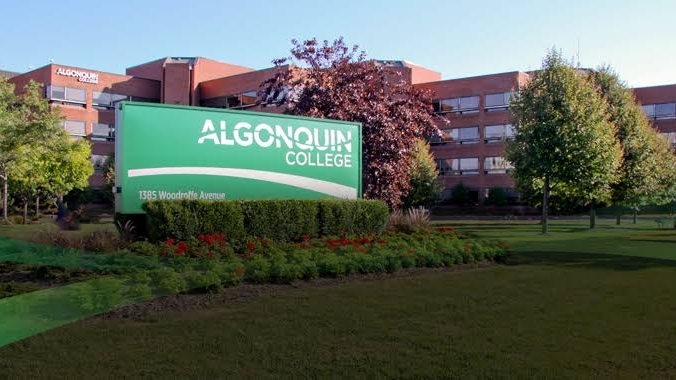
In 1967, the institution was founded as part of the development of Ontario’s college system. When the Ontario system of public colleges was founded on May 21, 1965, colleges of applied arts and technology were created.
The Eastern Ontario Institute of Technology (founded in 1957) and the Ontario Vocational Centre Ottawa were the founding institutions (established in 1965 at the Woodroffe Campus and known as OVC). Mr. and Mrs. Frank Ryan gave the original 8-acre land on Woodroffe Avenue to the city.
Algonquin Institution of Applied Arts and Technology is an English-language public college in Ottawa, Ontario, Canada.
The institution serves the National Capital Region as well as the surrounding regions of Eastern Ontario, Western Quebec, and Upstate New York.
The college has three locations, all of which are in Ontario: an Ottawa major campus and secondary campuses in Perth and Pembroke. Bachelor of Criminology certificates holders from the criminology department and from all departments are available in a variety of fields.

It has been named one of Canada’s top 50 research colleges and has been acknowledged as one of the country’s top innovators. The Ministry of Training, Colleges and Universities Act is the enabling legislation. Polytechnics Canada is a member.
Algonquin College Campuses — Algonquin Centre Campus
The Algonquin Centre for Construction Excellence, which opened in the fall of 2011 and was designed by Edward J. Cuhaci & Associates Architects in collaboration with Diamond Schmitt Architects, houses 600 additional construction seats and provides space for thousands more students studying in related programs.
The LEED Platinum certified building is a teaching laboratory for best practices in sustainable construction and is one of the most environmentally friendly buildings in the world.
A $4 million pedestrian bridge built across Woodroffe Avenue connects the relocated bus stop and a new below-grade transit lane (yet to be finished) to the main campus.
Algonquin College Campuses — Student Commons Campus
The 110,000-square-foot (10,000 m2) Student Commons project, which opened in the autumn of 2012, is the product of a continuing relationship between the College and its Students’ Association.
The Algonquin College Students’ Association, unlike most Ontario institutions, manages a variety of College services, from varsity athletics to the Algonquin Fitness Zone.
In order to provide additional social and study space for students, the SA Board of Directors decided to devote a portion of its activity fee to secure $30 million to fund the new Student Commons after consulting with its members.
The College’s Board of Governors approved an additional $22 million in financing for the project, recognizing the opportunity to improve and centralize student support services.
Algonquin College Campuses — Waterfront Campus
The 100,000-square-foot (9,300-square-meter) Pembroke Campus addition, which opened in autumn 2012, offers more than 300 full-time student seats.
These spaces are housed in a modernist building in Pembroke, Ontario, on the Ottawa River. The College, the City of Pembroke, and Renfrew County all see the new waterfront campus as a fresh start.
A new building would allow the College to expand, allowing it to better address the long-term labor market demands of Renfrew County employers.
Algonquin College Admission Requirements
Below is listed the recommended English proficiency score to pursue a diploma in criminology in Canada at Algonquin College.
1. Applicants with international transcripts must show verification of the subject-specific requirements listed above, as well as one of the following: OR TOEFL-Internet-based (iBT)-overall 88, with a minimum of 22 in each component: IELTS-International English Language Testing Service-Overall band of 6.5 with a minimum of 6.0 in each band; OR TOEFL-Internet-based (iBT)-overall 88, with a minimum Reading, listening, speaking, and writing are all worth 22 points.
Application Fee:
The application fee for international students is $95.
You can apply here.
Scholarships
Algonquin College Scholarships
12. Wilfrid Laurier University

Wilfrid Laurier University (often known as WLU or just Laurier) is a public university in Ontario, Canada, with campuses in Waterloo, Brantford, and Milton.
The institution sees itself as a “multi-campus multi-community university” and does not consider the newer Brantford and Milton campuses to be satellite campuses of the original Waterloo site.
With approximately 15,000 full-time undergraduate students, over 1000 full-time graduate students, and nearly 4,000 part-time students as of fall 2019, the institution provides undergraduate and graduate degrees in a range of subjects. The Wilfrid Laurier Golden Hawks, Laurier’s varsity teams, compete in the West Conference of the Ontario University Athletics, which is associated with U Sports.

Laurier’s purple and gold school colors date back to its early affiliation with the University of Western Ontario, when they were maroon and gold.
Although the relationship with Western waned after 1960, the colors have stayed. About 17,000 full-time and part-time undergraduate students and approximately 1,500 full-time and part-time graduate students attend the university. It has lecturers with Bachelor of Criminology certificates and staffs of around 500 people.
Laurier was ranked seventh out of 15 Canadian institutions in Maclean’s magazine’s comprehensive university category in their survey of Canadian universities in 2022.
Wilfrid Laurier University Campuses — Waterloo Campus
Wilfrid Laurier University’s business school, the Lazaridis School of Business & Economics, is located in Waterloo, Ontario.
There are over 160 full-time and 60 part-time faculty members. Wilfrid’s school has the most faculty. All of the school’s undergraduate, master’s, and doctoral programs are accredited by the Association to Advance Collegiate Schools of Business (AACSB International).
Wilfrid Laurier University Campuses — Brantford Campus
The Brantford Campus of Laurier University is located in Brantford, Ontario, about 50 kilometers south of the Waterloo campus.
The campus first opened its doors in 1999, with 39 students in its first year. The school had 2,625 full-time students and an unspecified number of part-time students enrolled as of January 2015.
Laurier predicted a total of over 3,000 students in late 2017. Laurier’s “Standout Programs” in 2017-2018, according to Maclean’s, includes Game Design and Development at the Brantford campus. “Not only does the program teach game design, project management, and entrepreneurship, but it also looks at how transformative games are employed in fields like education, corporate training, and health care.”
Wilfrid Laurier University Campuses — Kitchener Campus
The Faculty of Social Work (formerly on the Waterloo campus) relocated to downtown Kitchener in the fall of 2006.
It relocated to the old St. Jerome’s High School on Duke St., which was classified as a heritage property by the City of Kitchener.
The students were able to be closer to the community and social service agencies with which they were collaborating. Faculty and staff also hosted the Political Coffee House Series, multiple all-candidates debates, and the Expressions of Social Justice Festival in an effort to better partner with the community and make the building more welcoming.
Wilfrid Laurier University Campuses — Milton Campus
Since 2008, the town of Milton, Ontario, and Laurier University have collaborated to build a 150-acre campus in Milton as part of the Milton Education Village (MEV) property granted by the town.
In April 2018, the provincial government announced a $90 million funding plan for the MEV, which would include a satellite campus for the university as well as Conestoga College, a new partner in the project. Construction was planned to be completed in Q3 of 2021, however Laurier will begin offering credit courses in rented space in September 2019.
Wilfrid Laurier University Admission Requirements
Below are the details of your English proficiency requirements if you’re an intend to pursue a diploma in criminology in Canada.
1. TOEFL iBT (Internet-based testing of English as a Foreign Language): an overall score of 83 or above, with a minimum score of 20 in each component; 560 or higher on paper-based testing.
2. An academic score of 6.5 or above on the International English Language Testing System (IELTS), with a minimum of 6.0 in each band.
3. CAEL (Canadian Academic English Language Assessment) – 70 or above overall (each band 60 or higher).
4. 59 or higher on the Pearson Test of English Academic (PTE).
5. Overall score of 176 on the Cambridge Assessment English (CAE).
Application Fee:
The application fee for international students can be between $85 – $125.
You can apply here.
Scholarships
President’s Gold Scholarships
Laurier Tuition Bursary
Conclusion
There you have it! We have been able to show you with detailed description the best 12 criminology universities in Canada which also cut in extension among the best criminology universities in the world to study criminology.
We are sure you’ve learnt a lot from it.
Now the ball is in your court.
Choose one of these universities and go for it.
This is how we come to the end of this well researched article. If you have any questions or concerns kindly tell us by using the comment box.
We’ll be glad to help.
